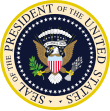President's Committee on Civil Rights
The President's Committee on Civil Rights was a United States presidential commission established by President Harry Truman in 1946. The committee was created by Executive Order 9808 on December 5, 1946, and instructed to investigate the status of civil rights in the country and propose measures to strengthen and protect them.[1][2] The committee submitted the report of its findings, entitled To Secure These Rights, to President Truman in December 1947,[3] and Truman proposed comprehensive civil rights legislation to Congress, and ordered antidiscrimination and desegregation throughout the government and armed forces.
 | |
| History | |
|---|---|
| Established by | Harry Truman on December 5, 1946 |
| Disbanded | December 1947 |
| Related Executive Order number(s) | 9808, 9980, 9981 |
| Membership | |
| Chairperson | Charles Edward Wilson |
| Other committee members | Sadie T. Alexander James B. Carey John Sloan Dickey Morris Ernst Roland B. Gittelsohn Frank Porter Graham Francis J. Haas Charles Luckman Francis P. Matthews Franklin Delano Roosevelt Jr. Henry Knox Sherrill Boris Shishkin Dorothy Rogers Tilly Channing Heggie Tobias |
| Jurisdiction | |
| Purpose | Investigate the status of civil rights in the country and propose measures to strengthen and protect them |
| Policy areas | Civil rights |
| Summary | |
| |
History
editThe committee was charged with examining the condition of civil rights in the United States, producing a written report of their findings, and submitting recommendations on improving civil rights in the United States. In December 1947, the committee produced a 178-page report entitled To Secure These Rights: The Report of the President’s Committee on Civil Rights. In the report, it proposed to establish a permanent Civil Rights Commission, Joint Congressional Committee on Civil Rights, and a Civil Rights Division in the Department of Justice; to develop federal protection from lynching; a permanent fair employment practice commission; to abolish poll taxes; and urged other measures.[4] Furthermore, the report raised the distinct possibility that the UN Charter from 1945 could also be used as a source of law to fight persistent racial discrimination in the US.[5]
On July 26, 1948, President Truman advanced the recommendations of the report by signing Executive Order 9980 and Executive Order 9981. Executive Order 9980 ordered the desegregation of the federal work force and Executive Order 9981 ordered the desegregation of the armed services[1]. He also sent a special message to Congress on February 2, 1948, to implement the recommendations of the President's Committee on Civil Rights.[6]
The President's Committee on Civil Rights report also paved way for African-American diplomats to break into previously white-dominated positions. Under President Truman, Edward R. Dudley would become the first African American given an ambassadorship, in part due to the findings of race-relations from the committee. However, these moves were largely done due to a harming of foreign relations due to the United States' race problem. Even with the committee's findings, President Truman had trouble acting on his own research, due to domestic backlash.[7]
Membership
editThe committee was composed of 15 members:[8]
Publication
edit- President's Committee on Civil Rights. To Secure These Rights: The Report of the President's Committee on Civil Rights. Washington: GPO, 1947.
See also
edit- Executive Order 8802, signed by President Franklin D. Roosevelt on July 25, 1941, to prohibit ethnic or racial discrimination in the nation's defense industry
- National Emergency Committee Against Mob Violence
References
edit- ^ "Executive Orders Disposition Tables". National Archives. 2016-08-15. Retrieved 2021-02-03.
- ^ "Executive Order 9808—Establishing the President's Committee on Civil Rights | The American Presidency Project". www.presidency.ucsb.edu. Retrieved 2021-02-03.
- ^ "Records of the President's Committee on Civil Rights Record Group 220 | Harry S. Truman". www.trumanlibrary.gov. Retrieved 2021-02-03.
- ^ President's Committee on Civil Rights. To Secure These Rights (2004).
- ^ Christopher N.J.Roberts. "William H. Fitzpatrick's Editorials on Human Rights (1949)". Quellen zur Geschichte der Menschenrechte. Retrieved November 4, 2017.
- ^ "Special Message to the Congress on Civil Rights, Public Papers of the Presidents, Harry S. Truman, 1945-1953" on February 2, 1948, from the Truman Presidential Museum & Library, retrieved January 21, 2006
- ^ Krenn, Michael. The History of United States Cultural Diplomacy, 1770 to Present Day. New York: Bloomsbury Academic, 2017.
- ^ "Agency History, Records of the President's Committee on Civil Rights Record Group 220" from the Truman Presidential Museum & Library, retrieved January 23, 2006
Notes
edit- ^ "Executive Order 9980, Regulations Governing Fair Employment Practices Within the Federal Establishment," and "Executive Order 9981, Establishing the President's Committee on Equality of Treatment and Opportunity in the Armed Services, Harry S Truman" from Federal Register, retrieved January 23, 2006. For more details on the desegregation of the armed forces see, "Truman Library: Desegregation of the Armed Forces Online Research File" from the Truman Presidential Museum & Library, retrieved May 4, 2010.
Further reading
edit- Berman, William C. (1970). The Politics of Civil Rights in the Truman Administration. Ohio State University Press. ISBN 9780814201428.
- Gardner, Michael R. (2002). Harry Truman and Civil Rights: Moral Courage and Political Risks. Southern Illinois University Press. ISBN 9780809388967.
- Hamby, Alonzo L. (1973). Beyond the New Deal: Harry S. Truman and American Liberalism. Columbia University Press. ISBN 9780231083447.
- McCoy, Donald R.; Ruetten, Richard T. (1973). Quest and Response: Minority Rights and the Truman Administration. University Press of Kansas. ISBN 9780700600991.
- Vaughan, Philip H. (1976). The Truman Administration's Legacy for Black America. Mojave Books. ISBN 9780878810475.
External links
edit- To Secure These Rights: The Report of the President’s Committee on Civil Rights Full text of document available from the Truman Presidential Museum & Library
- Christopher N.J. Roberts: William H. Fitzpatrick’s Editorials on Human Rights (1949), published by Arbeitskreis Menschenrechte im 20. Jahrhundert, published at "Quellen zur Geschichte der Menschenrechte"